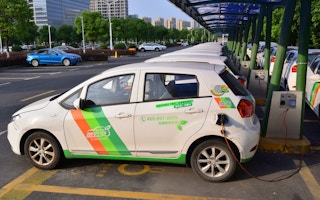Tesla’s recent introduction of Full Self-Driving (FSD) vehicles in China has reignited Internet debates about the future of autonomous vehicles (AVs). Some said this technology fell short of expectations, while others complained about higher prices compared to Chinese competitors. The backlash from Chinese consumers against Tesla underscores a stark lesson: even global AV leaders cannot seamlessly export data-driven models. Chinese EV brands have established domestic reputations for affordable and reliable autonomous driving services. Yet models trained exclusively on Chinese data and regulations remain untested in overseas markets.
Chinese and American EV giants are now venturing into the Southeast Asian market as the region becomes a testing ground for competing autonomous driving versions. Global technology giants are cautiously optimistic about Southeast Asia’s autonomous driving market. First, e-commerce growth, which reached US$159 billion in 2024 – is straining logistics networks and creating demand for autonomous delivery services. Second, Southeast Asia – motorcycles in Hanoi, tuk-tuks weaving through Bangkok, and various jeepneys dominating Manila – presents a testing lab of global transportation diversity.
This mirrors the urban-rural divide and encapsulates the challenges of the Global South. Third, proactive policies matter. In Singapore, for example, the Singapore Autonomous Vehicle Initiative prioritises public-private R&D alliances. These efforts signal a recognition of governments that autonomous mobility could accelerate Southeast Asia’s transition to become tech-driven economies.
To fully utilise the region’s potential, Chinese firms like Xpeng are flooding the region with affordable EVs equipped with Level 2-3 autonomy, backed by digital infrastructure investments under the Belt and Road Initiative (BRI). BYD, another Chinese pioneer, is deploying localisation-first strategies, partnering with Southeast Asian ride-hailing giants like Grab to provide better navigation and routing for drivers. Meanwhile, US players such as Waymo focus on premium logistics corridors, hoping to leverage Singapore’s high-tech ports to pilot autonomous freight systems.
In addition to Chinese and American automakers, manufacturers and suppliers from other countries and regions are trying to promote autonomous driving in Southeast Asia. For example, TÜV SÜD, a German company offering services to international automakers like BMW, is collaborating with Singapore’s Centre of Excellence for Testing and Research of Autonomous Vehicles to tackle challenges of AVs. It has established the AI Procured platform in Singapore to qualify autonomous driving.
Japan is carving niches via hybrid models: Toyota is conducting collaborative research with Singapore’s Ministry of Transport to adapt sensors and autonomous driving systems to local needs. Startups in Southeast Asia are tailoring solutions to local needs. For instance, Phenikaa-X has completed Vietnam’s first AV trial and presented smart transportation solutions and multifaceted autonomous driving applications at the Vietnam-Asian 2024 Smart City Summit.
Whether they are nimble local startups or deep-pocketed global titans, all players must confront Southeast Asia’s geopolitical and socioeconomic diversity. Economically, the stark disparities in geography, climate, infrastructure, and society across Southeast Asia are forcing companies to either develop country-specific models tailored to local conditions or invest heavily in algorithmic upgrades and expanded training data to maximise a unified model’s versatility. Either approach significantly drives up costs. Given the relatively low per capita income in Southeast Asia, such services risk pricing themselves out of the market or saddling firms with unsustainable losses.
Politically, Asean’s regulatory mosaic complicates cross-border data transfer and protection. Due to local computing power limits, companies have to centralise data processing and training. As a result, coordinating with governments to ensure seamless data flows is a key challenge. Otherwise, training with incomplete data will yield unreliable results, as in the case of Tesla’s China-specific FSD.
Public acceptance is another hurdle. According to a 2023 survey, most Indonesians distrust autonomous driving, citing safety and traffic complexity in Jakarta. Moreover, governments have to address job displacement concerns, especially in logistics-dependent economies such as Indonesia and the Philippines. This would help prevent recurrences of the San Francisco Waymo arson.
Last year, a robotaxi drove into the city’s Chinatown during the Lunar New Year, leading some in the crowd to set the car on fire. Public acceptance issues are compounded by cybersecurity vulnerabilities and ethical dilemmas. In short, companies steeped in Chinese or Western norms face a reality check: public scepticism and crises necessitate recalibrated crisis playbooks. To tackle these challenges, companies must dedicate resources to building adaptive frameworks.
Addressing these challenges requires action from companies and Southeast Asian governments. First, Asean should accelerate regulatory alignment by developing interoperable regulation frameworks that enable secure, efficient cross-border flows for AV training data, reducing costs while strengthening model reliability.
Second, facing fiscal constraints, governments should collaborate with the Asian Infrastructure Investment Bank and Asian Development Bank to build more “autonomy-ready” infrastructure, including smart highways, edge computing grids, and cybersecurity hubs. Finally, public engagement is key: demystifying AI through transparent pilot programmes could ease public concerns about safety and job displacement.
The road ahead is steep but navigable. Autonomous driving in Southeast Asia will not mirror the Chinese or American models. The key question is not whether autonomous driving will arrive in Southeast Asia, but how government and companies will navigate the regional complexities.
This article was first published in Fulcrum, ISEAS – Yusof Ishak Institute’s blogsite.











